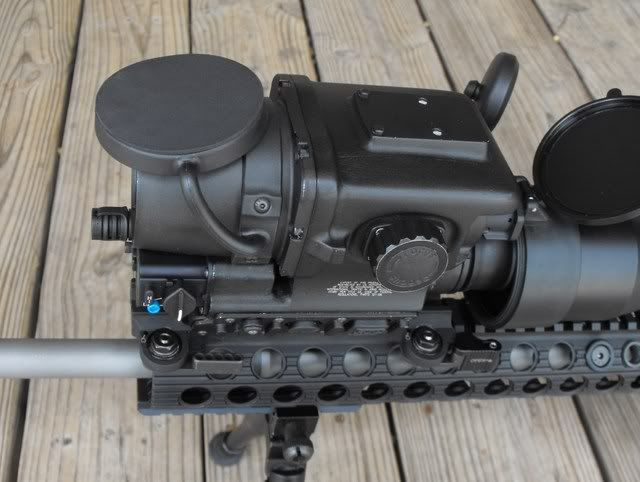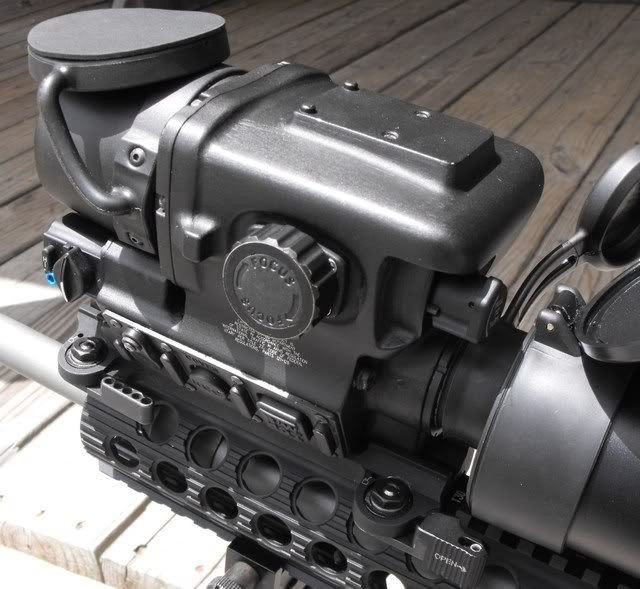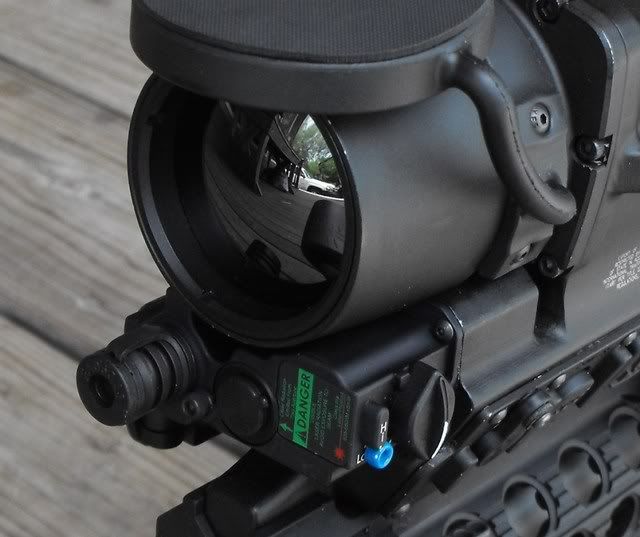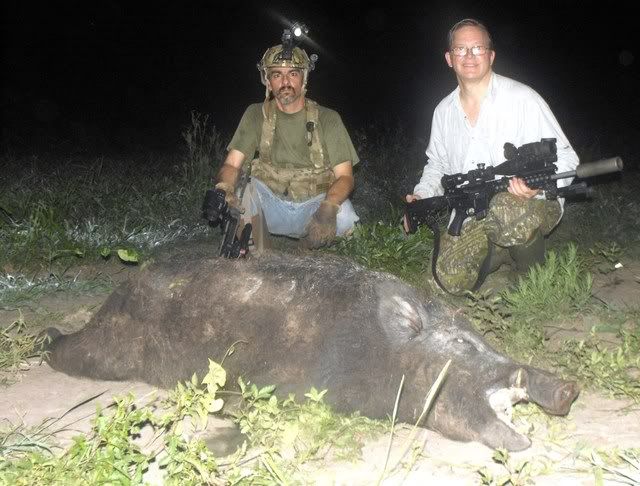This past weekend, I had the opportunity to shoot the FLIR T-60 and kill a hog with it as well. The unit was sent to me for testing by Sierra Pacific Innovations. They stock some of FLIR's original units, which were designed to be used in tandem with a Trijicon 4 X 32 ACOG. The body housing has since been changed a little but these are still the most sought after thermal clip-on weapon sights.
<span style="font-weight: bold">T-60 on 6.8 SPC</span>:

The body housing was specifically designed to fit the objective lens area of the Trijicon and the eyepiece lens is consequently rather small. It worked just fine behind a myriad of optics like the Eotech, the Aimpoint, and a Zeiss 4.5-14 X 50 with Mil-dot reticle. The brightness is tremendous and actually was too bright in front of the 50mm Zeiss so we placed a Wilcox Amber filter over the back of the scope's eyepiece, and that was just about perfect. I would like to see a manual gain control on this unit. The focus is conveniently located on the left side of the unit, so that the shooter can manipulate it with his left hand. The "NUC" (non-uniform calibration)and polarity buttons sit on the left side as well.
<span style="font-weight: bold">"NUC", polarity and laser power switch on left side, on/off is on the rear left corner....also notice proximity to the objective of the Zeiss</span>:

The T-60 has a 640 X 480 microbolometer and Is rated up to .50 BMG. It has the large 65mm lens and two selectable FOV settings, one that is 0.5X, providing a much broader area of viewing for spotting (14 degrees). Proper collimation is not achieved with this setting, and the shooter must instead use the 1.0X setting for shooting (which gives 7 degree FOV). We shot it on .308 and 6.8 SPC rifles, with no problems whatsoever.
The unit is powered on by the switch on the left rear of the unit. The FOV setting is on this switch, then the user rotates it clockwise to get first to 0.5 then another click to 1.0. The unit must be NUC'ed when turned on, manually, and thereafter every few minutes to refresh the bolometer's temperature differential sensing capability. The lens cap must be placed over the obj lens to prevent ghosting of a previous image. We found this to be a little cumbersome while stalking hogs, and would have preferred a manual shutter refresh, but that's just us. Some people like the manual capability.
Its really pretty simple. You just turn it on, and go to the FOV setting you want. If spotting, use 0.5 and when shooting, go to 1.0. Then refresh every so often. Once you are focused, you usually don't need to adjust your optic much. The crosshairs were always in focus even when we had to adjust the T-60's focus for distance.
The unit also has an IR laser with a select switch which changes the power from Class 1 to class 3b, and also a pressure pad switch but we did not need it. As with most thermals, this unit has video out, but I was much more concerned with getting my client a hog than trying to video, so sorry for no through the optic video...this time. If you want to see my thermal videos go to www.wildriverranch.net, and click on the video on the home page. More are coming soon.
Laser with switchable power:

All in all, we liked the capability of a clip-on unit. I have decided that I will likely never buy a dedicated thermal weapon sight, because I always have to positively ID with NV anyway. We have never shot a cow or calf in 10 years, and don't want to. Moreover, sweeping a weapon around to "spot" is never safe, IMO. Most likely, I will own a clip-on thermal, so that I can use it as a spotter (including behind a spotting scope) and / or on any rifle that has a rail space in front of my optic. Here's the hog we shot with the T-60. We saw it at 600 yards, easily and stalked to within 100 yards to take the shot. With this much magnification, my hunter placed the shot well and it was easily recovered. Watch for video, showing this kill, on WRR's Youtube channel to be posted soon.

For more information on tactical hog hunts, and how to demo this gear yourself, go to www.wildriverranch.net.
<span style="font-weight: bold">T-60 on 6.8 SPC</span>:

The body housing was specifically designed to fit the objective lens area of the Trijicon and the eyepiece lens is consequently rather small. It worked just fine behind a myriad of optics like the Eotech, the Aimpoint, and a Zeiss 4.5-14 X 50 with Mil-dot reticle. The brightness is tremendous and actually was too bright in front of the 50mm Zeiss so we placed a Wilcox Amber filter over the back of the scope's eyepiece, and that was just about perfect. I would like to see a manual gain control on this unit. The focus is conveniently located on the left side of the unit, so that the shooter can manipulate it with his left hand. The "NUC" (non-uniform calibration)and polarity buttons sit on the left side as well.
<span style="font-weight: bold">"NUC", polarity and laser power switch on left side, on/off is on the rear left corner....also notice proximity to the objective of the Zeiss</span>:

The T-60 has a 640 X 480 microbolometer and Is rated up to .50 BMG. It has the large 65mm lens and two selectable FOV settings, one that is 0.5X, providing a much broader area of viewing for spotting (14 degrees). Proper collimation is not achieved with this setting, and the shooter must instead use the 1.0X setting for shooting (which gives 7 degree FOV). We shot it on .308 and 6.8 SPC rifles, with no problems whatsoever.
The unit is powered on by the switch on the left rear of the unit. The FOV setting is on this switch, then the user rotates it clockwise to get first to 0.5 then another click to 1.0. The unit must be NUC'ed when turned on, manually, and thereafter every few minutes to refresh the bolometer's temperature differential sensing capability. The lens cap must be placed over the obj lens to prevent ghosting of a previous image. We found this to be a little cumbersome while stalking hogs, and would have preferred a manual shutter refresh, but that's just us. Some people like the manual capability.
Its really pretty simple. You just turn it on, and go to the FOV setting you want. If spotting, use 0.5 and when shooting, go to 1.0. Then refresh every so often. Once you are focused, you usually don't need to adjust your optic much. The crosshairs were always in focus even when we had to adjust the T-60's focus for distance.
The unit also has an IR laser with a select switch which changes the power from Class 1 to class 3b, and also a pressure pad switch but we did not need it. As with most thermals, this unit has video out, but I was much more concerned with getting my client a hog than trying to video, so sorry for no through the optic video...this time. If you want to see my thermal videos go to www.wildriverranch.net, and click on the video on the home page. More are coming soon.
Laser with switchable power:

All in all, we liked the capability of a clip-on unit. I have decided that I will likely never buy a dedicated thermal weapon sight, because I always have to positively ID with NV anyway. We have never shot a cow or calf in 10 years, and don't want to. Moreover, sweeping a weapon around to "spot" is never safe, IMO. Most likely, I will own a clip-on thermal, so that I can use it as a spotter (including behind a spotting scope) and / or on any rifle that has a rail space in front of my optic. Here's the hog we shot with the T-60. We saw it at 600 yards, easily and stalked to within 100 yards to take the shot. With this much magnification, my hunter placed the shot well and it was easily recovered. Watch for video, showing this kill, on WRR's Youtube channel to be posted soon.

For more information on tactical hog hunts, and how to demo this gear yourself, go to www.wildriverranch.net.








